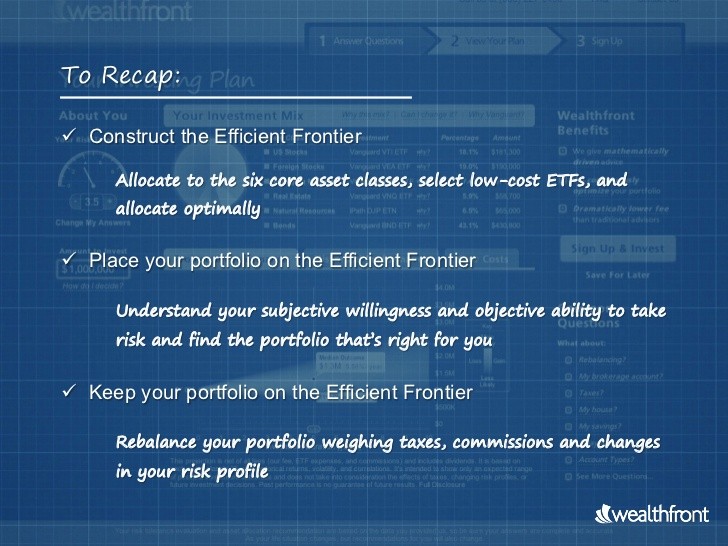Using ETFs in Your Portfolio
Post on: 18 Июль, 2015 No Comment

Your e-mail has been sent.
We believe that an appropriate way for most individuals to invest is to set a long-term target asset allocation consistent with their investment time horizon, risk tolerance, and financial situation, and then rebalance when needed. Within that context, the ups and downs of the market can offer opportunities for more active investors to over- or underweight market indexes, if they are willing to accept the risk of temporarily moving away from their long-term asset allocation.
A few things to know about ETFs
Learn more about ETFs
Like any investment vehicle, you need to understand how to use ETFs within your investment plan. If you want to invest in the whole U.S. equity market, a convenient proxy is the S&P 1500, which attempts to track the stocks of large, small, and mid-cap companies in the U.S. Of course, you can’t invest directly in an index, but certain index mutual funds and ETFs attempt to track the performance of an underlying index, like the S&P 1500, through a variety of techniques.
The S&P 1500 and ETFs that seek to track it, like iShares ® Core S&P Total U.S. Stock Market ( ITOT ), are weighted by the market capitalization of the stocks in the index. The biggest stocks hold a relatively bigger weight, while smaller companies make up a relatively smaller percentage of the index.
Using ETFs to reflect your investing expectations
What if you believe that small caps will outperform? Being that small caps represent a small percentage of the cap-weighted S&P 1500, a surge in small caps would have a very small impact on the overall value of the index.
Fortunately, there are ETFs that can help you invest based on targeted expectations (such as a forecast for small caps to shine). For example, S&P has separate indexes by cap size (small, mid-, and large cap) as well as style (growth and value). The ETFs that track these separate indexes give investors a way to make moves that are more tactical, on narrower slices of the market. One way to search for ETFs that track these and other indexes is to use our ETF Portfolio Builder .
Targeting a specific strategy using ETFs
Let’s say you are more bullish on a particular style, cap size, sector, or other segment of the market. With the Portfolio Builder, you can look at the market through seven preset market lenses, or filters, that group the market by sector, cap, or style (or you can create your own). For many of our preset lenses, the cap and style default reflects a portfolio of S&P iShares ® ETFs constructed to approximate the S&P 1500 index. In terms of market, the default was 88% large cap, 8% midcap, and 4% small cap stocks as of January 31, 2013.
Then you can adjust the allocation to suit your own situation, with the click of a mouse. And you can consider trading the resulting basket of ETFs online—with access to any of the 70 iShares ETFs that you can purchase commission free online at Fidelity.com.
Let’s take a look at how one hypothetical individual investor might use ETFs and the Fidelity ETF Portfolio Builder to construct a portfolio with broad exposure to the global markets, including some tactical investment decisions in areas he feels will perform particularly well as we come out of the economic downturn.
An ETF strategy in action
Assume a hypothetical investor, whom we will call Jim, has an overall asset allocation of 85% stocks (60% U.S. and 25% international) and 15% bonds. Jim measures his investment success relative to benchmarks that represent stocks and bonds in each of his primary asset classes. He uses the S&P 1500 as the benchmark for his U.S. stock exposure, the MSCI ® EAFE ® Index for his international stocks, and the Barclays Capital U.S. Aggregate Bond Index for fixed income.

Jim has $50,000 in U.S. equities in a taxable brokerage account that he is looking to rebalance and reallocate based on his views of the market and the economy.
Jim has looked at past economic cycles and feels that if the economic recovery in the United States gains momentum midcap and small cap stocks may lead the way. He would like to build a portfolio using ETFs to express this belief.
As you can see in the style and cap illustrations below, Jim first uses the ETF Portfolio Builder to get a sense of where the S&P 1500 is allocated across the different capitalizations (large, mid-, and small cap) and styles (growth and value). Within the Portfolio Builder under Customize a Model Portfolio, he clicks on “S&P iShares under Capitalization Models. He is then served up a model portfolio of iShares that roughly replicates the S&P 1500 Index (see Allocation % below).*
In addition, the Default Allocation %” initially displays the market weightings of the ETF components of the model portfolio (see Default Allocation % column in chart below).
Jim’s $50,000 ETF Portfolio
All sample screen shots shown in this article are as of 3/11/2013 and are for illustrative purposes only. Pricing and other information may change throughout the day based on market events. Variances are due to rounding, as ETFs may be purchased only in whole shares.
If Jim clicks on the Style tab to the right of the adjusted portfolio in the screener, he can view its Equity Style Profile (see below). The first box shows the cap/style makeup of the adjusted portfolio, which is Large Blend, according to Morningstar’s cap and style definitions. The second box shows the actual index by capitalization and style, as a comparison.














